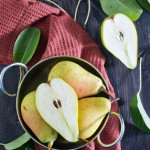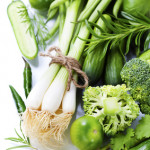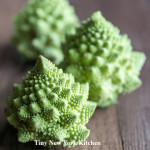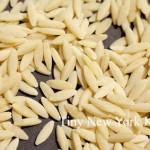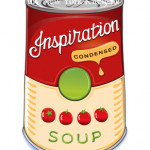Drizzling olive oil over savory fruits like tomatoes is second nature, but put it on sweet fruit and people start to think you’re crazy. Consider this: Olive and watermelons are both fruits, and just as vegetable-driven salads need fat to balance salt and acid, fruit salads crave the mouth-coating richness of oil to complement their sweetness and acidity. Olive oil is ideal since it brings a sharp aromatic flavor of its own that carries other savory ingredients, like nutty sharp cheeses and spicy sauce. Look for lighter, grassy oils to avoid overwhelming your fruits, but even a bold, peppery one can play nice with whatever you care to throw at it.
“Work With What You Got!”
©Tiny New York Kitchen © 2018 All Rights Reserved
Sometimes, the best way to cook fresh produce is the simplest way of all.
For roasting vegetables, put them on a baking sheet, sprinkle with olive oil and a bit of kosher salt, and cook in a hot oven until tender, turn once or twice.
For steaming vegetables, put a small amount of water in a saucepan and heat over a medium-high heat until tender, as little as 2 minutes or up to 10, depending on the vegetable.
“Work With What You Got!”
©Tiny New York Kitchen © 2018 All Rights Reserved
Pulling a tender, juicy roast chicken with crisp, golden brown skin out of the oven is so rewarding. For a simple side, roast a pan of in-season produce like spring onions, ramps, new potatoes or carrots during the last 20 minutes of cooking.
INGREDIENTS
1 Whole Chicken (4 Pound)
1 Teaspoon Sea Salt
1/2 Teaspoon Freshly Ground Pepper
Preheat oven to 425 degrees.
Remove neck and giblets from chicken. Trim off any excess fat from neck and tail end of chicken. Rinse bird with cool running water. Pat dry with paper towels, and season all over with salt and pepper.
Place chicken, breast side up, on a rack in a small-size roasting pan or a 9×13 inch-baking dish. Tuck wings back and behind bird to hold them in place. Roast, basting once or twice with pan juices, until skin is deep golden brown and juices run clear, about 1 1/2 hours.
An instant-read thermometer inserted in the thickest part of the thigh should read 165 degrees. Let chicken rest for 15 minutes and then carve.
To add fragrant flavor, stuff the cavity with a halved lemon or orange and a handful of fresh herbs like rosemary, thyme, and oregano.
Serve with an easy salad of greens topped with cherry tomatoes, mozzarella, and a drizzle of olive oil.
Serves 4
Prep Time: 20 Minutes
Cook Time: 90 Minutes
Total Time: 110 Minutes
“Work With What You Got!”
©Tiny New York Kitchen © 2018 All Rights Reserved
Olive oil is rich in unsaturated fat and is also an anti-inflammatory, but all olive oils aren’t created equally. As you may have heard, not all imported olive oil is 100% pure olive oil because it’s mixed with other types of oils. It’s important to know what type of olive oil you’re purchasing. To avoid spoilage make sure to store olive oil away from heat, air, and light. Here is a quick guide on selecting oil for all of your cooking needs.
EXTRA VIRGIN
Extra virgin olive oil comes from the olive’s first cold press. The highest quality unrefined oil available; EVOO has a pure, fruity flavor and is best used for drizzling on salads, vegetables, and proteins and dipping bread into.
ORGANIC
Organic olive oil is very similar to extra virgin in terms of how it’s made, the quality, and the flavor. The difference is that organic olive oil is made using only certified organic olives.
LIGHT
“Light” refers to flavor, not fat or calories. Light olive oil is a refined oil that has a high smoke point and neutral flavor, so it’s great for frying, sautéing, and baking.
PURE
If you need an all-purpose cooking oil, pure olive oil fits the bill. It’s a blend of virgin and refined oils, leaving it with a neutral taste.
“Work With What You Got!”
©Tiny New York Kitchen © 2018 All Rights Reserved
The colder months are when a rainbow of fruits and vegetables reach their peak, from dark green kale to sunny citrus.
Jicama
Pronounced hee-cah-ma, this winter vegetable is crunchy and refreshing. Its mild flavor makes it perfect for salads, salsa, or as crudités for your favorite dip. Use a vegetable peeler to remove its tough skin. When chopping, pick the ones with taut skin and firm flesh.
Turnips
This phytonutrient-rich root vegetable becomes sweeter as you cook it, shedding any bitterness along the way. The greens are particularly good for you and make an easy side sautéed with some garlic in olive oil.
Beets
Putt off by the long cooking time for beets? Reach for conveniently precooked packages in the produce section, or enjoy them raw. Peel them and grate them into salads or smoothies.
Parsnips
Earthy, sweet parsnips are loaded with fiber and minerals like folate and potassium. Older parsnips can have a somewhat fibrous core, which you can cut out before cooking if you prefer a softer texture.
Red Cabbage
High In antioxidants, red cabbage is great for slaws, but unlock a whole new world of flavor by sautéing, roasting or even grilling it.
Citrus
This category of fruit is at its peak right now, so take full advantage. The beauty of citrus is that it can swing from sweet to savory. These fruits stay fresh for weeks in the fridge, so keep a variety on hand to brighten up breakfasts, lunches, and dinners. Lemons, limes, and grapefruit are easy-to-find mainstays, but don’t be afraid to experiment with blood oranges, key limes, Meyer lemons, kumquats, pomelos, and clementines.
Brussels Sprouts
Full of fiber and vitamins K and C, this once-maligned cruciferous vegetable (from the same family as cauliflower and cabbage) is way more versatile than you think. Try it raw, roasted, fried, steamed, or sautéed.
Kale
This leafy green has gone from tossed-aside garnish to hot trend to salad staple. Whether you choose the curly or lacinato type, kale is high in vitamins K, C, and A, as well as carotenoids like lutein to promote eye health.
“Work With What You Got!”
©Tiny New York Kitchen © 2018 All Rights Reserved
Cut Into Pieces (like you would broccoli)
Steam
Add 1 to 2 Tablespoons, Butter, Ghee or Clarified Butter
Add 1 Tablespoon Spice Mixture Of Your Choice
OR
Preheat Oven to 425 degrees. Line Baking Sheet With Parchment Paper
Scatter Pieces Onto Baking Sheet
Drizzle With Olive Oil
Season With Kosher Salt & Pepper
Place In Oven 15 to 20 Minutes Until Tender
“Work With What You Got!”
©Tiny New York Kitchen © 2018 All Rights Reserved
I like to eat seasonal fruits and vegetables. Brussels sprouts are a hearty winter vegetable and are sweetest and most tender after a hard frost. They are a good source of fiber, antioxidants, and vitamin C. Look for young, small green sprouts that have tightly formed buds. Avoid any yellowing, which means that the sprouts will be bitter, sulfurous, and tough. Use fresh sprouts within a few days after purchasing. Sprouts sold on the stalk tend to keep longer. Brussels sprouts can be boiled, braised, or steamed. Cut an X at the base of each sprout to allow for a more even cooking. Add a bit of butter, olive oil, salt, pepper, garlic, onions, or herbs of your choice. Brussels sprouts also make a nice addition to stir fry, noodles, and other dishes. As always, be creative and “work with what you got!”
“Work With What You Got!”
© Victoria Hart Glavin Tiny New York Kitchen © 2017 All Rights Reserved
The end of summer is fresh produce heaven, which includes delicious vine ripened tomatoes. What do you do when you have a tomato abundance?
Here are some tips for making the most of the end of summer tomatoes.
Sliced: Incorporate into sandwiches or add to basil and mozzarella for a Caprese Salad.
Chopped: You only need a few chopped heirloom tomatoes, mozzarella, chopped basil, and olive oil for a colorful no-cook pasta sauce.
Puréed: There’s nothing like an icy cold gazpacho on a warm day.
Salsa: Fresh salsa is a must have condiment for grilled steaks or shrimp, brown rice and beans, scrambled eggs, and of course, chips.
Grilled: Toss cherry tomatoes with olive oil, garlic, and herbs. Then cook in a grill basket until charred. Top fish, chicken, pasta, and charred slices of bread.
Stored: Keep tomatoes at room temperature until ripe and then use within a day or two. Don’t put them in the refrigerator as it affects their flavor and texture.
Preserved: Roasted, dehydrated, or stewed – savor the season by saving a taste of summer for later.
“Work With What You Got!”
© Victoria Hart Glavin Tiny New York Kitchen © 2017 All Rights Reserved
Orzo is the Italian word for barley; however, orzo is not made from barley at all, but rather from semolina, which is a course ground flour made from durum wheat. With its shape reminiscent of slivered almonds, orzo cooks up in about half the time of rice, making it a speedy standby to have on hand to add heartiness to meals.
Just bring 3 quarts of lightly salted water to a boil. Add 8 ounces ( 1 1/2 cups) dried orzo and boil about 10 minutes until it has a firm, chewy texture. Stir occasionally to prevent it from sticking together. Drain orzo in colander and serve immediately.
Rinse orzo only if it will be baked or served cold in a salad. Otherwise, do not rinse as rinsing removes a light coating of starch that helps sauces and seasonings cling to the pasta.
For the best texture and flavor serve orzo immediately after cooking. If your orzo gets done before the rest of the meal, you can keep it warm by returning the cooked drained pasta to the warm cooking pan. Stir in a little butter or olive oil to prevent it from sticking together. Cover the pasta with a lid and let it stand no more than 14 minutes.
“Work With What You Got!”
© Victoria Hart Glavin Tiny New York Kitchen © 2017 All Rights Reserved
While the Nutrition Fact label can tell you a lot about a food, you need to check the ingredients list to see what you’re really eating. Is your breakfast cereal made with whole grains or does your favorite salad dressing contain oil that is high in saturated fat, for example.
By law, ingredients lists must be ordered by weight. The heaviest ingredient goes first, followed by the next heaviest, and so on. It is not a good sign if sugar is the first ingredient in a cereal or when bad fats like partially hydrogenated soybean and cottonseed oils are the third ingredient listed on a can of biscuit dough.
Below is a list of common phrases found on many food packages:
Cholesterol Free or No Cholesterol: Don’t be fooled by the words No Cholesterol written across the label of a jar of peanut butter or bottle of canola oil. If you turn to the Nutrition Facts label, you’ll see that no brand of either food has cholesterol – and never did! Only foods of animal origin contain cholesterol. But manufacturers hope you don’t know that.
Light: This word is used to describe fat content, taste, or color. If the manufacturer is describing the fat content as “light,” the product has at least 50 percent less fat than the original. The label must also say “50% less fat than our regular product.” “Light” olive oil, on the other hand, describes the oil’s color. The oil is as caloric as regular olive oil, but has been processed to remove some of its flavor. A muffin mix can say “light and fluffy” as a way to describe its texture or consistency.
Low-Fat or Fat-Free: Low-fat products must contain 3 grams or less fat per serving and fat-free products must have less than 0.5 grams of fat per serving. But check the number of calories – that number could be very high. It is easy to gain lots of weight eating fat-free cookies because they are loaded with sugar.
Low Sodium or Light In Sodium: This means that the sodium was cut by at least 50 percent over the original product. Be careful when using a “low” version of a super-high-sodium food such as soy sauce or soup. You can still end up consuming a lot of sodium. Check the numbers on the Nutrition Fact Label.
Sugar-Free, No Added Sugars, Without Added Sugars: A sugar-free chocolate candy may not contain a speck of sugar, but it’s still got plenty of fat and calories. Be sure to check out the Nutrition Facts label to know how many calories and grams of saturated fat you’re consuming.
Sweetened With Fruit Juice, Fruit Juice Sweetener, or Fruit Juice Concentrate: These sweeteners are made by reducing fruit juice (usually grape juice) into a sticky sweetener. These sweeteners are not nutritious. They are just like sugar.
“Work With What You Got!”
© Victoria Hart Glavin Tiny New York Kitchen © 2017 All Rights Reserved

